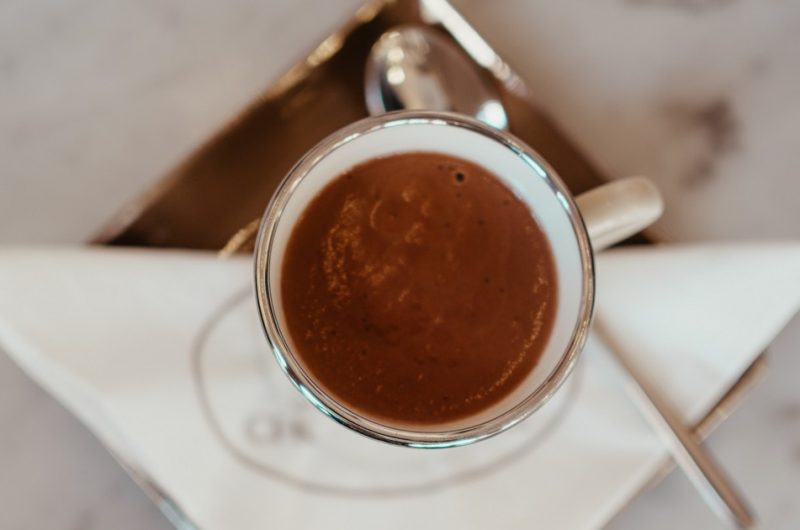Recipe: French-Vietnamese hot chocolate from Criollo Chocolatier
Stay at home orders due to the spread of COVID-19 are the great distance equalizer. It doesn’t matter whether we’re two kilometers or 3,000 miles from Toulouse. None of us has the pleasure of sitting in a lovely chocolate shop in France, sipping a decadent hot chocolate right now. However, that doesn’t mean that you can’t make your own travel experience while you #restezchezvous (#stayathome). This recipe for my favorite French hot chocolate will use the power of taste to transport you across the globe (or down the street) to a Toulouse chocolaterie.
I have long sung the praises of the amazing chocolatiers in Toulouse, writing about my favorite hot chocolate in Toulouse and where to buy chocolate Advent calendars. I even created the Chocolate & Pastry tour so that visitors (and locals) can experience these gourmet delights with me. One of the chocolatiers that guests hear me talk about most often is Criollo Chocolatier. Criollo is run by M. Jean-Pierre Dujon-Lombard – a self-taught maître artisan chocolatier who has been in the business since 2002. You can read more about the extraordinary story of how he got his start in this article by Culture 31 (in French, so have your Google translate extension handy).
Since then, M. Dujon-Lombard has delighted in stretching the boundaries of chocolate-making through collaborations with local chefs, writers, illustrators, and other artists. Many of his creations are based on flavors from around the world. I often say to my guests and friends that savoring a chocolate from Criollo is like experiencing the sense memory of a trip to some beautiful, special corner of the world.
The story behind the recipe
In 2011, and again in 2013, he collaborated with Sarah Truong Qui, the chef of L’Empereur d’Hué (a Vietnamese gastronomic restaurant in Toulouse that closed in 2018 after 20 years in business) to present a collection of Vietnamese-inspired chocolates. You can read more about their collaboration on Toulouse blog Mamscook (in French). This hot chocolate recipe is based on one of those chocolates, the Bao Dai. Named after the last emperor of Vietnam, the Bao Dai is a gorgeous ganache chocolate with a combination of red pepper and lime zest.
The hot chocolate version is served in the Criollo Chocolatier shop on the Place Saint Etienne, where Criollo has a salon de thé. As one of the first hot chocolates that I tasted after I moved to Toulouse, it will forever be one of my favorites. Between the rich, silky chocolate that we associate with France and the combination of bright, zesty lime with the slight heat of the red pepper that is a trademark of Vietnam, it’s like a trip around the world in one sip!
I was luck enough to get my hands on the recipe for this French hot chocolate last year and – fortunately for us right now – it’s not too difficult to make at home! So put the ingredients below on your list for the next time you venture out for grocery shopping. You’ll be taking armchair travel to the next level!
Recipe: French-Vietnamese hot chocolate by Criollo Chocolatier
Course: Drinks, DessertCuisine: French, VietnameseDifficulty: Easy2-4
servings10
minutes15
minutes55
minutesTransport yourself to a Toulouse chocolatier with this decadent – and easy – recipe for French hot chocolate with a Vietnamese twist.
Ingredients
75 mL (⅓ cup) cream
¼ tsp red pepper – or to taste (see note 1)
Zest of 1 lime
125 grams (4.4 ounces) of good-quality milk chocolate (see note 2)
250 ml (1 cup) milk – preferably not skim
Directions
- Heat the cream on the stove in a saucepan until it is at a simmer.
- Add the red pepper and lime zest and let them infuse on low heat for at least 20 minutes (I’d recommend trying for 30 if you can stand to wait – the longer you let the ingredients infuse, the stronger their flavor will be). If your stove won’t allow you to turn the heat down low enough so that the cream isn’t boiling, turn the heat off and on occasionally to keep the cream warm.
- After the infusion time is over, pass the cream through a sieve to remove the lime zest and any large bits of pepper.
- Return the cream to the stove and mix in the chocolate to melt it. (see note 3)
- If you are making your hot chocolate right away, go ahead and whisk in the milk, bringing the hot chocolate back up to serving temperature.
- Serve in small demitasse-size cups if you have them, as this is much richer than your average hot chocolate mix. (See note 4) Bon appétit!
Notes
- 1. I used dried Piment d’Espelette because I like the mild sweetness. You can also use red pepper flakes, or fresh or dried red chili peppers. Technically, the red pepper most often used in Vietnam is the Bird’s eye chiles – but use what you have and what tastes good to you. The level of spice will vary, so adjust the amount of spice and the infusion time accordingly.
- 2. Based on Criollo’s recipe, I used 25 g of Maracaibo 38% milk chocolate and 100 g of Quevedo 41% milk chocolate (bought directly from the chocolatier). You can also use dark chocolate, but you may want to add a little sugar, as it will be more bitter. Don’t skimp on the chocolate! Using good quality chocolate is the key to getting it to taste just like it does in the chocolate shop.
- 3. This chocolate and cream mixture is called ganache and can be made ahead of time and stored in an airtight container in the fridge for up to a month (online sources vary between 1 week and 1 month). Double – or triple – the recipe so you always have some on hand!
- 4. This recipe makes 4 small cups of hot chocolate – or two normal-size mugs.
- Translation note/disclaimer: This recipe was based on a set of hot chocolate recipes (in French) given to me by Criollo Chocolatier. If you’ve ever tried to make a French recipe, you’ll know they are structured and written much differently than recipes tend to be written in English. This is not a word-for-word translation and I have heavily adapted it, based on my own kitchen experiments and observations – so all mistakes are my own and should not reflect on Criollo Chocolatier.
Did you enjoy this article? Sign up for the Taste of Toulouse monthly email update and get restaurant news, food events, and more like this delivered piping hot to your inbox once each month!
Photo credits: Barthphotographie




